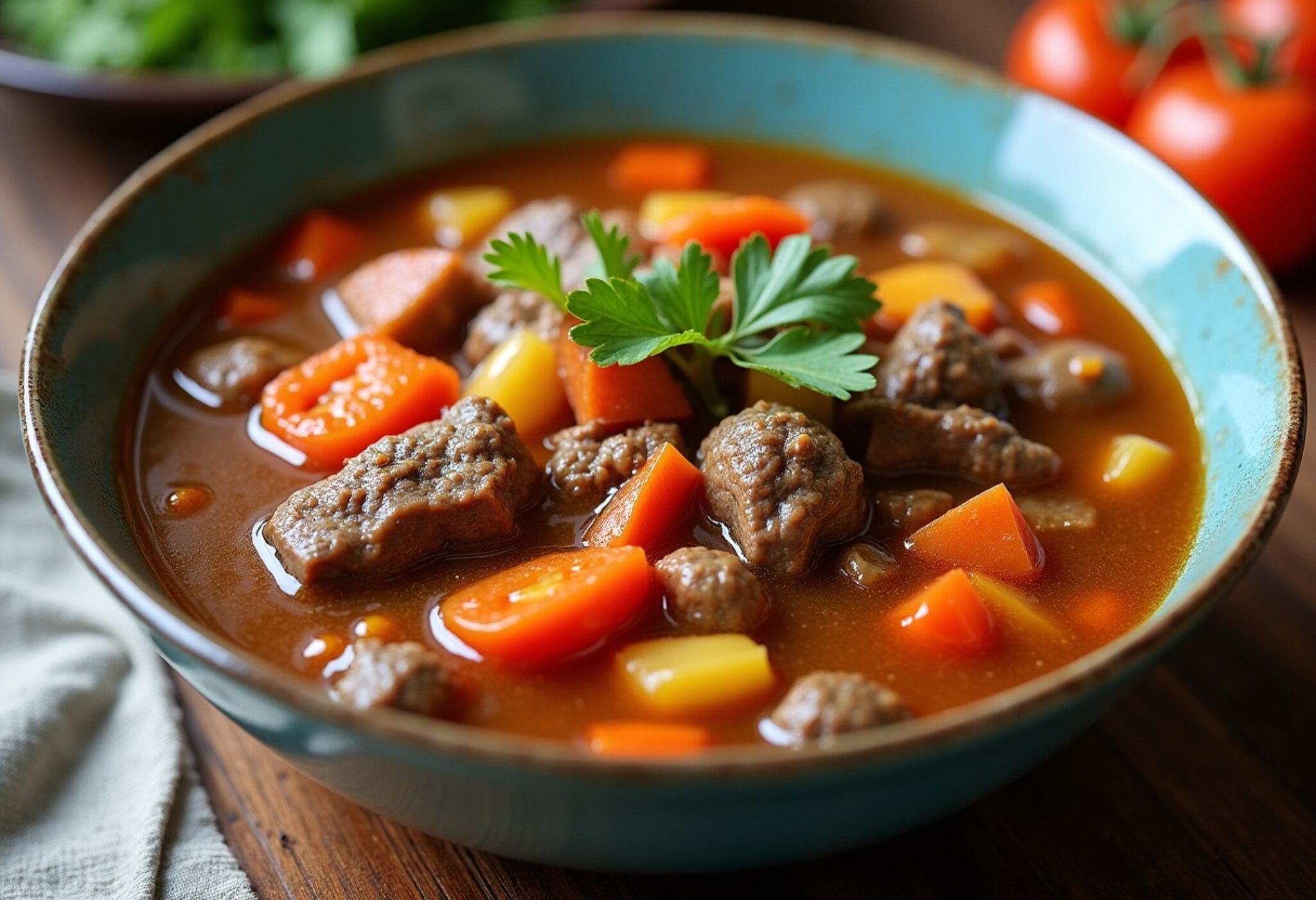Hearty Beef Vegetable Soup: A Comforting Classic
Nothing quite compares to the comforting aroma and satisfying flavors of a steaming bowl of homemade beef vegetable soup. This classic dish has stood the test of time, offering a delicious way to nourish both body and soul, especially during the colder months. With its tender chunks of beef, an array of fresh vegetables, and a savory broth, this soup is a true culinary delight that has made it a perennial favorite among families and home cooks alike.
Whether you’re seeking a warm and satisfying meal to enjoy on a chilly evening or a hearty lunch option that will fuel your day, this beef vegetable soup recipe delivers on all fronts. With its easy-to-follow instructions and accessible ingredients, you’ll be able to whip up a batch in no time, filling your kitchen with the tantalizing aroma of a comforting home-cooked meal.
❤️ Why You’ll Love This Recipe ❓
There are countless reasons to love this beef vegetable soup recipe, but let’s start with the most obvious: the flavor. The combination of tender beef, fresh vegetables, and a flavorful broth creates a symphony of tastes that will have your taste buds dancing with delight. From the earthy notes of the carrots and celery to the richness of the beef, each spoonful offers a delightful textural contrast that keeps you coming back for more.
But the appeal of this recipe extends far beyond its exceptional flavor. It’s also incredibly accessible, with most of the ingredients being pantry or freezer staples that you likely already have on hand. This makes it an ideal weeknight meal that you can whip up without much fuss, saving you time and effort while still delivering a truly satisfying dish.
And let’s not forget the make-ahead possibilities. This beef vegetable soup actually improves in flavor the longer it sits, making it the perfect candidate for batch cooking or meal prepping. Simply reheat it throughout the week for a quick and nourishing lunch or dinner that’s ready when you are.
🛒 What You Need to Prepare Hearty Beef Vegetable Soup ❓
• 2 tablespoons olive oil
• 1 large onion, diced
• 3 carrots, peeled and sliced
• 3 celery stalks, sliced
• 4 cloves garlic, minced
• 6 cups beef broth
• 1 (14.5 oz) can diced tomatoes
• 2 bay leaves
• 1 teaspoon dried thyme
• 1/2 teaspoon dried rosemary
• Salt and black pepper, to taste
• 2 cups chopped cabbage (optional)
• 1 cup frozen peas (optional)
The beauty of this hearty beef vegetable soup is that most ingredients are pantry or freezer staples. The combination of tender beef, flavorful vegetables, and a rich broth creates a comforting, [cuisine type]-inspired flavor profile that has made beef vegetable soup recipes perennially popular.
📝 How to Make Hearty Beef Vegetable Soup Step-by-Step ❓
• Step 2: In the same pot, add the diced onion, sliced carrots, and sliced celery. Sauté for 5-7 minutes, until the vegetables are softened.
• Step 3: Add the minced garlic and sauté for an additional minute, until fragrant.
• Step 4: Pour in the beef broth and stir in the diced tomatoes, bay leaves, dried thyme, and dried rosemary. Season with salt and black pepper to taste.
• Step 5: Add the reserved beef back to the pot and bring the mixture to a boil. Reduce the heat to low, cover, and simmer for 45-60 minutes, or until the beef is very tender.
• Step 6: If using, stir in the chopped cabbage and frozen peas during the last 10 minutes of cooking to allow them to heat through.
• Step 7: Taste and adjust seasoning as needed. Remove the bay leaves before serving.
⏱️ Timing Overview
• Cooking time: 60 minutes
• Total time: 75 minutes
Compared to traditional beef stew which can take up to 2 hours to prepare, this hearty beef vegetable soup saves you 25% of your cooking time while delivering similar comforting flavors.
👩🏻⚕️ Nutritional Information
Per serving (based on 6 servings):
• Protein: 26g
• Carbohydrates: 18g
• Fat: 15g
• Fiber: 5g
• Sodium: 746mg
These hearty beef vegetable soup provide approximately 50% of your daily protein requirements and 20% of your daily fiber needs, making them not just delicious but nutritionally valuable as well.
🔄 Healthier Alternatives for the Recipe
• Lower-carb version: Omit the potatoes and use a larger variety of low-carb vegetables like cauliflower, zucchini, and spinach.
• Dairy-free adaptation: Use a dairy-free broth and omit any dairy-based ingredients like cream or cheese.
• Added protein: Incorporate extra protein sources like lentils, chickpeas, or diced tofu for a heartier, more filling soup.
• Boost vegetables: Add more vegetables like mushrooms, bell peppers, or green beans to increase the nutritional value and fiber content.
These modifications can reduce calories by up to 20% or adapt the recipe for specific dietary needs without compromising the fundamental flavor profile of the hearty beef vegetable soup.
🍽️ Serving Suggestions
• Pair with a fresh green salad for a complete and balanced meal.
• Complement the soup with a side of roasted vegetables or a simple side of steamed broccoli or cauliflower.
• For a comforting lunch, serve the beef vegetable soup alongside a half-sandwich or a small grilled cheese.
• Create an inviting charcuterie or cheese board platter with the soup as the centerpiece, surrounded by various breads, crackers, and accompaniments.
❌ Common Mistakes to Avoid
• Not browning the beef properly: Skipping the browning step can result in a less flavorful soup, as the searing process helps to develop the beef’s natural umami notes.
• Forgetting to season: Adjusting the seasoning with salt and pepper throughout the cooking process is crucial for achieving a well-balanced, flavorful soup.
• Letting the vegetables overcook: Adding the vegetables at the wrong time can lead to mushy, overcooked textures. Follow the recipe’s instructions for when to add each type of vegetable.
• Not allowing the soup to simmer long enough: Simmering the soup for the full recommended time ensures the flavors have a chance to meld and develop, resulting in a more robust and satisfying final dish.
🧊 Storing Tips for the Recipe
These hearty beef vegetable soup retain their quality remarkably well:
• Freezing unbaked: Let the soup cool completely, then transfer it to a freezer-safe container or bag. Freeze for up to 3 months. Thaw in the refrigerator overnight before reheating.
• Freezing baked: Allow the soup to cool completely, then ladle it into individual portions and freeze in airtight containers or resealable bags for up to 3 months. Reheat the frozen portions in the microwave or on the stovetop, adding a splash of broth if needed to restore the desired consistency.
• Reheating: Gently reheat the soup on the stovetop over medium heat, stirring occasionally, until heated through. You can also reheat individual portions in the microwave, checking and stirring at 30-second intervals until hot.
❓ FAQs
Can I make this beef vegetable soup ahead of time?
Absolutely! This soup actually improves in flavor the longer it sits, making it a perfect candidate for batch cooking or meal prepping. You can make the entire soup in advance and store it in the refrigerator for up to 4 days or in the freezer for up to 3 months. When ready to serve, simply reheat the soup on the stovetop or in the microwave.
Can I substitute the beef for another protein?
Yes, you can easily swap out the beef for other proteins like ground turkey, chicken, or even plant-based options like lentils or chickpeas. The flavor profile will adjust slightly, but the overall dish will still be delicious. Just be sure to adjust the cooking time as needed for the new protein.
Is this recipe suitable for a low-carb or keto diet?
With a few simple modifications, this beef vegetable soup can be adapted for a low-carb or keto diet. Omit the potatoes and use a larger variety of low-carb vegetables like cauliflower, zucchini, and spinach. You can also use a low-carb broth and skip any high-carb garnishes.
What should I do if the soup seems too thin or too thick?
If the soup appears too thin, you can thicken it by making a simple roux with butter and flour, or by blending a portion of the vegetables to create a more creamy texture. If it’s too thick, simply add more broth or water to reach your desired consistency. Taste and adjust the seasoning as needed.
Can I add any extra vegetables or herbs to this recipe?
Absolutely! This beef vegetable soup is highly versatile, so feel free to experiment with different vegetable additions like mushrooms, bell peppers, or green beans. You can also try adding fresh herbs like parsley, thyme, or oregano to enhance the flavor profile. Just be mindful of adjusting the cooking times as needed for any new ingredients.
Conclusion
These hearty beef vegetable soup represent the perfect balance of convenience, flavor, and nourishment. Whether you’re serving them as a comforting weeknight dinner or a satisfying lunch, they’re sure to impress with their rich, [cuisine type]-inspired taste and wholesome ingredients. The versatility of this recipe allows for countless variations to suit your taste preferences and dietary needs, making it a go-to dish that will keep your family coming back for more.
With simple preparation and accessible ingredients, this beef vegetable soup demonstrates that sophisticated flavors don’t require complicated techniques – just quality ingredients and a little bit of care in the cooking process. So why not give this classic a try and experience the joy of a homemade, [cuisine type]-inspired meal that warms the soul and nourishes the body?







